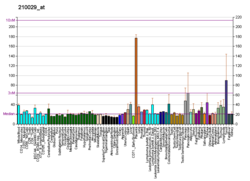| IDO1 |
|---|
 |
| Visualisation de la protéine Cristallisée IDO1 |
| Structures disponibles |
|---|
| PDB | Recherche d'orthologue: PDBe RCSB |
|---|
| Identifiants PDB |
|---|
2D0T, 2D0U, 4PK5, 4PK6, 4U72, 4U74, 5EK2, 5EK3, 5EK4, 5ETW |
|
|
| Identifiants |
|---|
| Aliases | IDO1 |
|---|
| IDs externes | OMIM: 147435 MGI: 96416 HomoloGene: 48082 GeneCards: IDO1 |
|---|
| Position du gène (Homme) |
|---|
 | | Chr. | Chromosome 8 humain[1] |
|---|
| | Locus | 8p11.21 | Début | 39,902,275 bp[1] |
|---|
| Fin | 39,928,790 bp[1] |
|---|
|
| Position du gène (Souris) |
|---|
 | | Chr. | Chromosome 8 (souris)[2] |
|---|
| | Locus | 8|8 A2 | Début | 25,074,152 bp[2] |
|---|
| Fin | 25,087,025 bp[2] |
|---|
|
| Expression génétique |
|---|
| Bgee | | Humain | Souris (orthologue) |
|---|
| Fortement exprimé dans | - palpebral conjunctiva
- epithelium of nasopharynx
- appendice iléo-cæcal
- nasal epithelium
- placenta
- ganglion lymphatique
- muqueuse utérine
- gonade
- upper lobe of left lung
- rectum
|
| | Fortement exprimé dans | - dorsal striatum
- mucous cell of stomach
- Jéjunum
- duodénum
- Villosité intestinale
- noyau accumbens
- Cellule de Paneth
- globus pallidus
- glande submandibulaire
- muscle plantaire
|
| | Plus de données d'expression de référence |
|
|---|
| BioGPS |  | | Plus de données d'expression de référence |
|
|---|
|
| Gene Ontology |
|---|
| Fonction moléculaire | - dioxygenase activity
- liaison ion métal
- heme binding
- electron transfer activity
- activité d'oxydoréductase
- indoleamine 2,3-dioxygenase activity
- tryptophan 2,3-dioxygenase activity
| | Composant cellulaire | - cytoplasme
- stereocilium bundle
- cytosol
- smooth muscle contractile fiber
| | Processus biologique | - negative regulation of interleukin-10 production
- multicellular organismal response to stress
- positive regulation of interleukin-12 production
- processus du système immunitaire
- gestation
- positive regulation of T cell tolerance induction
- cytokine production involved in inflammatory response
- positive regulation of chronic inflammatory response
- negative regulation of T cell apoptotic process
- regulation of activated T cell proliferation
- response to lipopolysaccharide
- negative regulation of T cell proliferation
- positive regulation of apoptotic process
- tryptophan catabolic process
- positive regulation of type 2 immune response
- réponse inflammatoire
- kynurenic acid biosynthetic process
- positive regulation of T cell apoptotic process
- swimming behavior
- tryptophan catabolic process to kynurenine
- chaîne de transport d'électrons
- 'de novo' NAD biosynthetic process from tryptophan
| | Sources:Amigo / QuickGO |
|
| Orthologues |
|---|
| Espèces | Homme | Souris |
|---|
| Entrez | | |
|---|
| Ensembl | | |
|---|
| UniProt | | |
|---|
| RefSeq (mRNA) | | |
|---|
| RefSeq (protéine) | | |
|---|
| Localisation (UCSC) | Chr 8: 39.9 – 39.93 Mb | Chr 8: 25.07 – 25.09 Mb |
|---|
| Publication PubMed | [3] | [4] |
|---|
|
| Wikidata |
| Voir/Editer Humain | Voir/Editer Souris |
|

 Portail de la médecine
Portail de la médecine  Portail de la biologie cellulaire et moléculaire
Portail de la biologie cellulaire et moléculaire 


















